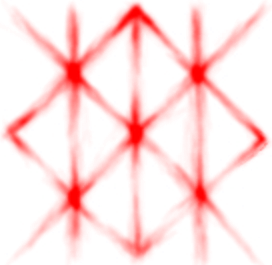3. The Beginning
According to the Norse creation myth, at the beginning, there were three primordial realms:
- Niflheim - the world of mist and source of the Water.
- Ginnungagap - a middle area made of Emptiness.
- Muspelheim - the world of the Fire.
Some sources mention that Muspelheim was the first and Niflheim was created a bit later. For us, it doesn't matter a lot, but we can use it as a hint to start learning the Fire first.
The middle world Midgard we live in was created from the body of proto-giant (Jötunn) Ymir, who emerged as a result of interaction between Water and Fire happening in the middle Emptiness. Ymir gave birth to the next generation of jötnar and was killed by Odin with his brothers.
This process of world creation we interpret as an alchemical process that can be reproduced by practitioners in their microcosm.
Creation is the root of everything. If something is mentioned in the creation myth - most likely it's very important because it will influence everything that will happen after.
We see three major "things" exist before everything: Fire, Emptiness, and Water. It's not "just elements" - they are independent forces which are playing significant roles not only at the moment of creation but during the entire lifetime of the universe.
Norse mythology emphasizes the concept of an inevitable and unseen force of Fate, personified by the Norns, to which even the gods must submit. The idea of such a hidden director force that oversees the entire story from behind the scenes matches very well with the mysterious nature of Emptiness. Despite being occupied by our world, we will find that Emptiness is still around us, and we can touch it.
This is a distinctive and very important feature of Norse mythology - it's not monistic nor dualistic.
Number three is the most important in Norse Tradition (alongside nine).
The very beginning of the universe is based on three principles:
Two opposites and something else in the center, the axis pointing upward, adding a third dimension of evolution to the ideal but flat balance of duality.
Separation and Distinction
Nothing is said about what was before and we don't know what it was, but something was divided into two opposite parts and these parts were separated by the force of division and they remain separated, it means this force is still here, keeping our world from collapse back to unknown unity.
When we divide One into Two - nothing else remains, but Emptiness. If it was ever One, then One contained everything:
The upper part we call "Water"
The lower part we call "Fire."
The space in between and force that started division and keeps things separate we call "Emptiness".
These two opposites are not material water and fire we know, but something different and outside of our world, yet we can still access, feel, and interact with them.
Fire feels heavy, hot, and dense, more like lava than flame. There is an ocean of fire right below our feet, and one can feel the vibration of its power through the very soles.
The Water feels light, cool, and fluid. It feels more ethereal than the water we know, like the liquid light of stars, giving a menthol feeling when it pours onto the top of one's head.
Emptiness is not nothing but space, a source of order, just enough space to set us free.
